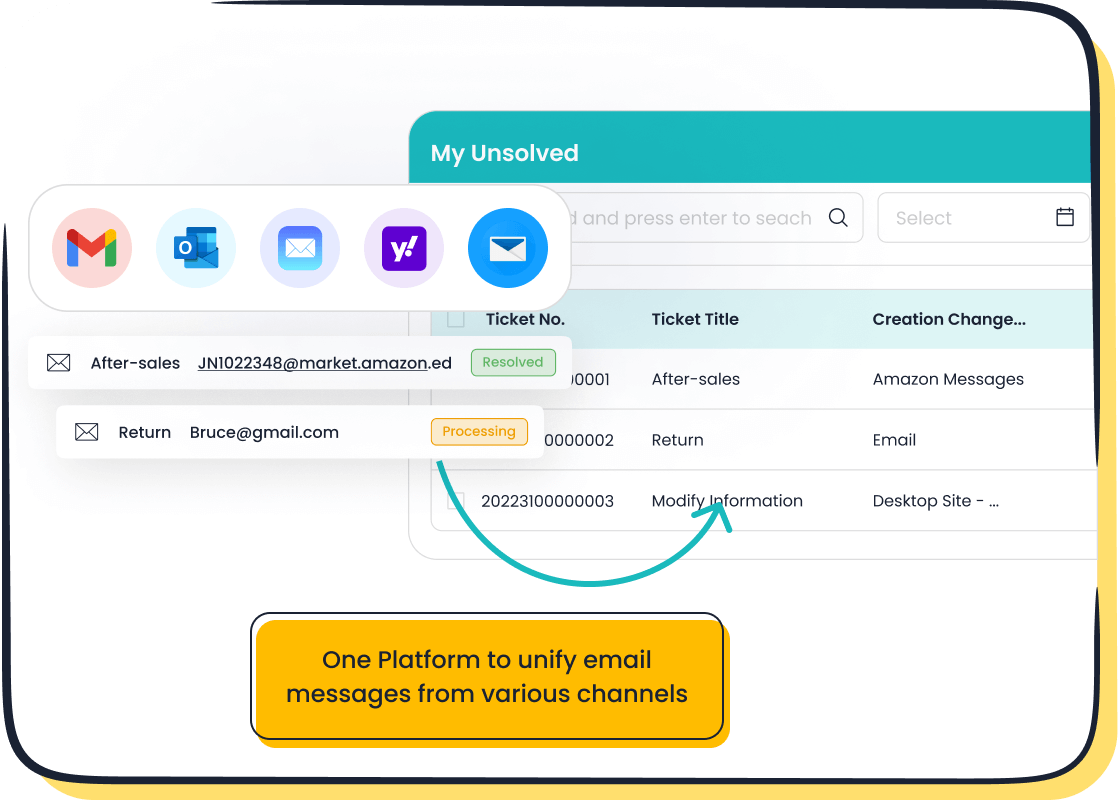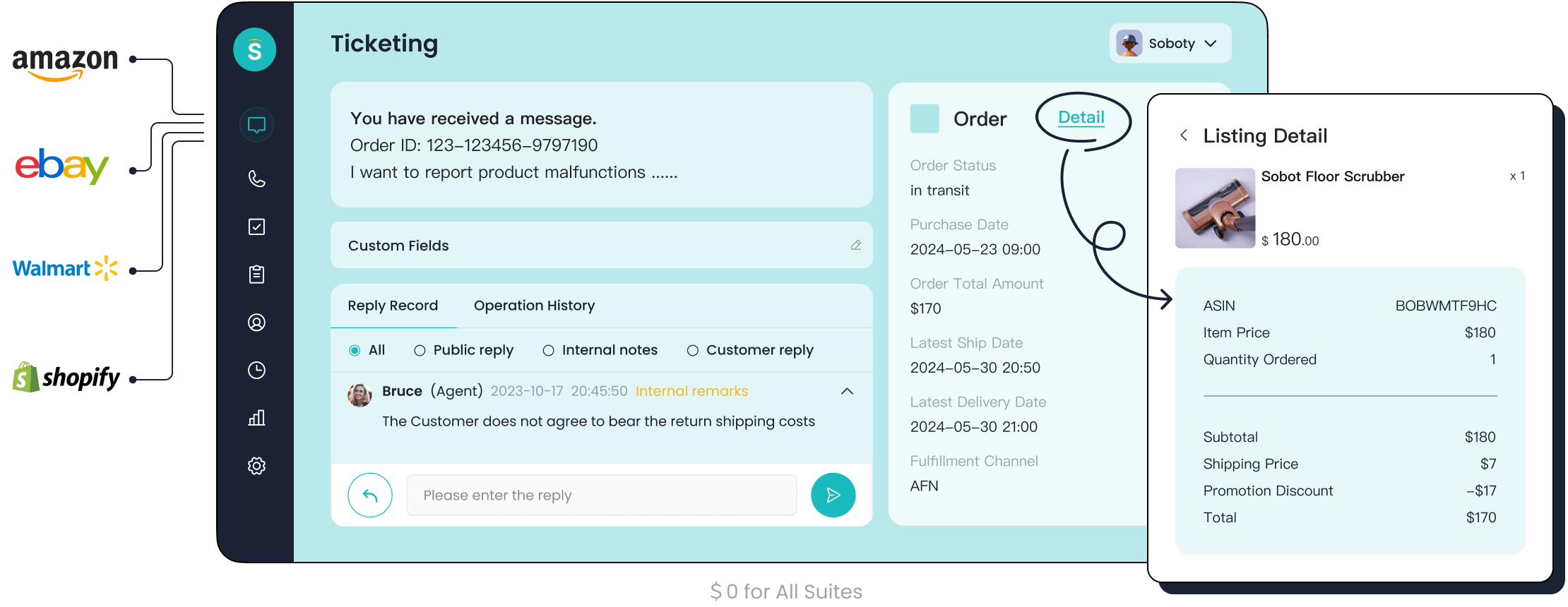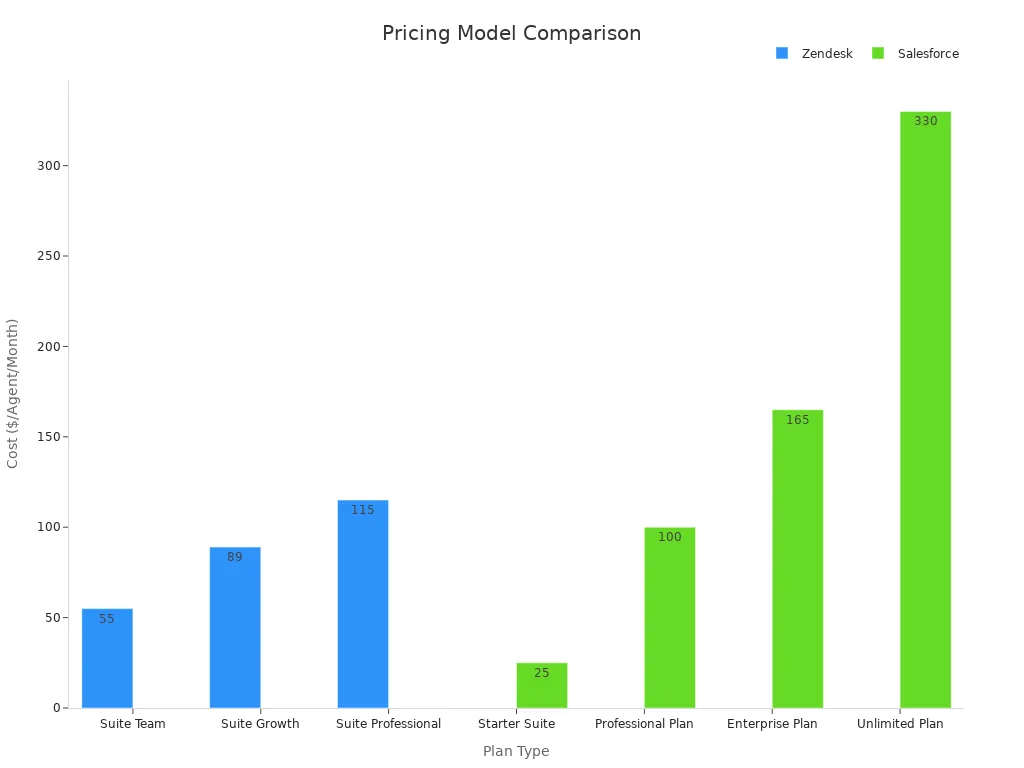Top Zendesk alternatives for customer service teams this year

If you need the best Zendesk alternatives for customer service teams in 2025, consider these powerful options: Sobot, Freshdesk, Zoho Desk, Intercom, HubSpot Service Hub, and Tidio. Sobot stands out with unified multi-channel support, AI-powered helpdesk, and predictive analytics that boost customer satisfaction and efficiency. Sobot AI enables seamless customer support across chat, email, and voice, making it easy to use for any team size. In 2025, alternatives to zendesk like Sobot improved customer satisfaction and operational efficiency, with one retail company seeing a 25% increase in customer lifetime value. Choosing the right customer service platform helps you deliver multi-channel support, automate workflows, and maximize results with customer service software that adapts to your needs.
Why Switch from Zendesk?
Common Challenges
Many customer support teams face hurdles when using traditional helpdesk platforms. You may notice that costs rise quickly as you add features or scale your team. The interface can feel complex, making it hard for new agents to learn and slowing down daily tasks. Teams often struggle with limited flexibility, which means you need extra development or third-party apps to meet unique needs.
Real-world examples show that companies sometimes use automation tools to bridge gaps between their helpdesk and IT systems, but this adds more steps and potential errors. For instance, a global financial services firm needed to integrate their helpdesk with IT operations to speed up incident resolution and reduce mistakes.
You might also find it challenging to keep up with changing business needs, such as new product launches or busy seasons. Staff absences, ticket surges, and the need to automate repetitive tasks can impact your service quality. Collaboration among agents can suffer if the platform lacks features like side conversations or easy ticket sharing. Some teams even report slow or generic customer support from their provider, which affects customer satisfaction.
What Teams Want
Customer support teams now look for alternatives to zendesk that offer more agility and better customer experience. You want a helpdesk that collects feedback from many sources—surveys, social media, and direct messages. Real-time analysis and AI-driven insights help you understand customer needs faster. Automation is key, letting you trigger actions or assign cases without manual work.
- Teams demand:
- Seamless integration across channels for a unified view.
- Advanced analytics and predictive models to improve customer satisfaction.
- Easy-to-use interfaces that reduce onboarding time.
- Strong automation to handle repetitive tasks and free up agents.
- Multilingual support for global reach.
Platforms like Sobot address these needs by offering an AI-powered helpdesk that unifies chat, email, and voice. Sobot’s omnichannel solution helps you manage all interactions in one place, making it easier to deliver consistent service and boost customer satisfaction. With features like automated ticket routing, SLA management, and trusted analytics, you can focus on what matters most—improving the customer experience.
Quick Comparison: Alternatives to Zendesk

Features Overview
You want a clear view of what sets the best zendesk alternatives apart. The table below gives you a comprehensive comparison of leading platforms. Sobot stands out with unified multi-channel support, AI-powered ticketing, and seamless integration. You can manage all customer conversations in one cloud-based help desk, making your team more efficient.
| Platform | Multi-Channel | AI & Automation | Integrations | Analytics | SLA Management | Multilingual | Cloud-Based Help Desk |
|---|---|---|---|---|---|---|---|
| Sobot | ✅ | ✅ | ✅ | ✅ | ✅ | ✅ | ✅ |
| Freshdesk | ✅ | ✅ | ✅ | ✅ | ✅ | ✅ | ✅ |
| Zoho Desk | ✅ | ✅ | ✅ | ✅ | ✅ | ✅ | ✅ |
| Intercom | ✅ | ✅ | ✅ | ✅ | ✅ | ✅ | ✅ |
| HubSpot SHub | ✅ | ✅ | ✅ | ✅ | ✅ | ✅ | ✅ |
| Tidio | ✅ | ✅ | ✅ | ✅ | ❌ | ✅ | ✅ |
Sobot’s unified omnichannel workspace and AI-powered ticketing help you deliver consistent service across chat, email, and voice. This makes it a top choice for teams seeking affordable help desk software with advanced automation.
Pricing Comparison
You need affordable pricing and better pricing models to fit your budget. The following table gives you a comprehensive comparison of pricing for each platform. Sobot offers flexible plans that scale with your needs, making it a budget-friendly option for growing teams.
| Platform | Pricing Model & Cost Breakdown | Value Proposition Supported |
|---|---|---|
| Sobot | Tiered, affordable pricing; custom enterprise plans available | Unified multi-channel, AI-powered, scalable |
| Freshdesk | Free tier, then tiered pricing; add-ons for advanced features | Accessible for small to mid-sized businesses |
| Zoho Desk | Affordable pricing with AI features | Cost-effective automation and efficiency |
| Intercom | Tiered, usage-based; higher cost for advanced features | Advanced engagement, scalable for larger teams |
| HubSpot SHub | Competitive, all-in-one pricing | Broad CRM and service integration |
| Tidio | Budget-friendly, simple plans | Live chat and automation for small businesses |

You see that Sobot and Zoho Desk offer affordable help desk software for teams that want cloud-based help desk solutions without high costs. These platforms provide budget-friendly options for startups and SMBs.
Best Use Cases
You want to choose the right platform for your business needs. Here is a comprehensive comparison of the best use cases for each alternative:
- Sobot: Best for businesses needing unified multi-channel support, AI-powered automation, and global scalability. Retail, finance, and enterprise teams benefit from its cloud-based help desk and omnichannel capabilities.
- Freshdesk: Great for small to mid-sized businesses looking for essential support features and affordable pricing.
- Zoho Desk: Ideal for companies seeking automation and multilingual support at a budget-friendly price.
- Intercom: Suited for SaaS and tech companies focused on customer engagement and onboarding.
- HubSpot Service Hub: Perfect for teams wanting all-in-one CRM and customer support software.
- Tidio: Best for small ecommerce and startups needing live chat and automation.
Sobot’s AI-driven ticketing and seamless integration make it a strong choice for teams that want to streamline operations and improve customer satisfaction.
Best Zendesk Alternatives Reviewed

Sobot Ticketing System
Sobot Ticketing System gives you a unified platform for managing customer support across chat, email, and voice. You can automate ticket management with AI, which means faster response times and fewer manual tasks. The system supports multilingual tickets, making it ideal for global teams. You can set custom triggers for ticket assignment and manage SLAs to ensure timely resolutions. Sobot integrates with popular e-commerce platforms like Shopify, so you can streamline support for online stores. The platform’s analytics dashboard helps you track performance and improve your helpdesk operations.
OPPO, a global smart device leader, used Sobot to handle peak shopping periods. By combining chatbots and human agents, OPPO achieved an 83% chatbot resolution rate and a 94% positive feedback score. Their repurchase rate increased by 57% after optimizing their support with Sobot.
Sobot’s omnichannel solution lets you manage all customer conversations in one place. You can merge tickets, use canned responses, and access a unified customer profile for every interaction. The system is easy to use, so your team can get started quickly. Sobot’s stability (99.99% uptime) and scalability make it a top choice among the best zendesk alternatives for businesses that want reliable, AI-powered helpdesk software.
Learn more about Sobot Ticketing System
Freshdesk
Freshdesk offers a cloud-based helpdesk that supports multi-channel communication. You can use built-in customer satisfaction surveys (CSAT, NPS) to gather real-time feedback. Productivity tools like knowledge bases and internal notes help agents resolve issues faster. Freshdesk’s automation features reduce manual work, so your team can focus on complex cases.
- Businesses using Freshdesk benefit from:
- High Net Promoter Scores (NPS), reflecting strong customer loyalty.
- High Customer Satisfaction (CSAT) scores, showing positive experiences.
- Fast first contact resolution and low average response times, which improve customer trust.
Freshdesk’s unified platform brings together all your support channels and customer data. Automation and AI-powered chatbots help you close tickets quickly, making it one of the best zendesk alternatives for teams that value efficiency and customer satisfaction.
Zoho Desk
Zoho Desk provides a flexible helpdesk solution with strong automation and multilingual support. You can set up workflows to automate ticket assignment and escalation. The platform’s AI assistant, Zia, helps you analyze trends and predict customer needs. Zoho Desk integrates with other Zoho apps and third-party tools, so you can build a connected support ecosystem.
You can customize ticket views, use pre-built templates, and access detailed analytics. Zoho Desk’s affordable pricing makes it attractive for small and mid-sized businesses looking for the best zendesk alternatives. Its easy onboarding process and intuitive interface help your team get up to speed quickly.
Intercom
Intercom focuses on conversational support with a modern, chat-first approach. You can engage customers through live chat, email, and in-app messaging. The platform’s AI chatbot, Fin, delivers human-like responses by learning from your help center content and past interactions. Intercom’s shared inbox and proactive campaigns help you deliver personalized support.
- Key strengths include:
- Seamless multi-channel engagement.
- AI-powered agent assist for real-time suggestions.
- Integrated knowledge base and analytics for continuous improvement.
Intercom’s dynamic workflows and conversational analytics make it a strong contender among the best zendesk alternatives, especially for businesses that want to create natural, real-time customer interactions.
HubSpot Service Hub
HubSpot Service Hub combines helpdesk, automation, and CRM in one platform. You can manage tickets, automate workflows, and track customer feedback from a single dashboard. The platform’s integration with HubSpot CRM gives you a complete view of every customer interaction.
You can use knowledge bases, live chat, and customer feedback tools to improve support quality. HubSpot’s reporting features help you measure team performance and customer satisfaction. Its all-in-one approach makes it a practical choice for businesses seeking the best zendesk alternatives with strong CRM integration.
Tidio
Tidio offers live chat and AI-powered chatbots for real-time customer support. You can use the drag-and-drop chatbot builder to automate FAQs and lead collection. Tidio supports multi-channel messaging, including WhatsApp, Messenger, Instagram, and email.
- Notable features:
- Plug-and-play templates for quick setup.
- Real-time visitor monitoring and analytics.
- Integration with eCommerce and ticketing platforms.
Tidio’s intuitive interface and easy-to-use AI flow designer help you optimize your support workflow. The platform’s automation capabilities reduce wait times and improve efficiency, making it a valuable option among the best zendesk alternatives for small businesses and startups.
The following table summarizes user ratings and trial information for several top alternatives:
| Tool | User Rating | Trial Info | Starting Price |
|---|---|---|---|
| LiveAgent | 4.5/5 | 30-day free trial | From $15/agent/month |
| Issuetrak | 4.1/5 | Free trial + demo | From $27/user/month |
| Tidio | N/A | 7-day free trial + free plan | From $25/user/month |
These ratings and trial options show how the best zendesk alternatives deliver value and flexibility for different business needs.
Key Features for Customer Service Teams

Omnichannel Support
You need to deliver a seamless customer experience across every channel. Omnichannel support lets you manage conversations from chat, email, voice, and social media in one helpdesk. This approach ensures customers receive consistent service, no matter how they reach out. Companies using omnichannel strategies see faster response times and higher customer satisfaction. For example, 48% of customers consider switching brands after poor service, while 61% will leave after just one negative experience (Salesforce, 2022). Platforms like Sobot unify multi-channel communication, giving you a complete view of each customer and making every interaction personal.
Automation & AI
Automation and AI transform customer support by reducing manual work and speeding up responses. You can use AI-powered ticket routing, chatbots, and automated workflows to handle repetitive tasks. Dell’s case study shows that automation can cut response times in half and boost conversion rates from 10% to 25%. Companies that respond to leads within an hour are seven times more likely to connect with decision-makers. Sobot’s AI-driven helpdesk features help you resolve tickets quickly, improve accuracy, and free your team to focus on complex issues.
Integrations
You need your helpdesk to connect with the tools you already use. Integrations with CRM, ecommerce, and analytics platforms streamline your workflow and reduce errors. Many alternatives now offer pre-built connectors and API access for custom data sources. For example, Sobot integrates with Shopify and Salesforce, letting you sync customer data and automate processes. This comprehensive connectivity supports real-time data sharing and helps you deliver better customer support.
Analytics & Reporting
Reporting and analytics give you the insights needed to improve your service. You can track key metrics like Customer Satisfaction Score (CSAT), First Contact Resolution (FCR), and Customer Effort Score (CES). These metrics help you spot trends, identify bottlenecks, and make data-driven decisions. Industry benchmarking shows that companies using analytics improve customer loyalty and retention. Sobot’s analytics dashboard provides real-time performance data, helping you set goals and measure progress.
Scalability
As your business grows, your customer support platform must scale with you. Scalable solutions handle more tickets, support more agents, and maintain fast response times. Companies have reduced response times from 24 hours to just 4 hours and increased tickets handled per agent from 50 to 200 per month by adopting scalable platforms. Sobot’s cloud-based helpdesk ensures stability and performance, even during peak periods, so you can keep delivering excellent service as demand rises.
Choosing the Right Zendesk Alternative
Assessing Needs
You should start by evaluating your business requirements. Every company has unique needs, so use a checklist to guide your decision:
- Identify your main support channels: chat, email, voice, or social media.
- Measure customer satisfaction using Net Promoter Score (NPS) and Customer Satisfaction Score (CSAT).
- Track metrics like First Reply Time and Resolution Time to understand support efficiency.
- Consider your team size, growth plans, and the need for multilingual support.
- Review feedback from customers and agents to spot gaps in your current system.
Industry benchmarks show that combining quantitative data (like CSAT) with qualitative feedback helps you understand what works best for your business. For example, retail and e-commerce teams often need omnichannel feedback and real-time monitoring to stay competitive.
Matching Features
Once you know your needs, compare features and performance outcomes. Use statistical methods like t-tests or regression analysis to see which platform delivers better results for your team. The table below summarizes common tests used to compare help desk features:
| Test Type | Use Case | Notes |
|---|---|---|
| T-tests | Compare two platforms | Simple, effective for small samples |
| ANOVA | Compare three or more platforms | Identifies overall differences |
| Regression | Predict outcomes from features | Useful for forecasting performance |
Look for platforms that offer automation, analytics, and integration with your existing tools. Sobot, for example, provides unified omnichannel support, AI-powered ticketing, and seamless integration with e-commerce platforms. You also want to consider pricing and scalability to ensure you choose affordable help desk software that grows with your business.
Migration Tips
A smooth migration is critical for business continuity. Follow these best practices:
- Audit your current system to identify essential data and features.
- Plan your migration steps, timeline, and resources.
- Involve your team in training and testing to ensure adoption.
- Ensure data accuracy and integrity with thorough testing before going live.
- Choose a provider like Sobot that offers expert migration support and minimal downtime.
Case studies show that companies achieve seamless transitions by focusing on data integrity, detailed planning, and ongoing support. Zero downtime and accurate data transfer are key success metrics. Post-migration, continue to monitor performance and optimize workflows for the best results.
You have many strong Zendesk alternatives to choose from this year. Sobot stands out for unified omnichannel support and AI-powered ticketing, making it ideal for growing teams and enterprises. Review the table below to see how platforms compare in user ratings:
| Platform | Number of Reviews | Average Rating | Positive Reviews | Neutral Reviews | Negative Reviews |
|---|---|---|---|---|---|
| Drift | 111 | 3.23 | 65 | 8 | 38 |
| Zendesk | 422 | 1.58 | 57 | 11 | 354 |
For startups, Sobot’s easy setup and automation help you scale quickly. Ecommerce brands benefit from seamless integrations and fast response times. Large enterprises trust Sobot for stability and advanced analytics. Use the comparison tables and checklist above to match your needs with the right solution. Choose a platform that fits your team’s goals and helps you deliver great service every day.
FAQ
What are the main benefits of choosing Zendesk alternatives like Sobot?
You gain unified omnichannel support, AI-powered ticketing, and seamless integration. Sobot helps you reduce response times by up to 50%. Many businesses see higher customer satisfaction and lower costs after switching to Zendesk alternatives.
How do Zendesk alternatives improve customer service efficiency?
Zendesk alternatives automate ticket routing, provide real-time analytics, and support multiple channels. For example, Sobot’s AI features help your team handle more tickets per hour. This leads to faster resolutions and happier customers.
Can Zendesk alternatives like Sobot integrate with e-commerce platforms?
Yes, most Zendesk alternatives offer integrations with platforms like Shopify. Sobot connects your helpdesk with your online store, so you can manage orders and support in one place. This integration streamlines your workflow and improves customer experience.
Are Zendesk alternatives suitable for global teams?
Absolutely. Zendesk alternatives such as Sobot support multilingual ticketing and global scalability. You can serve customers in different languages and regions. Sobot’s platform helps international teams deliver consistent, high-quality support worldwide.
Tip: Explore Sobot’s official website for more details on features and industry use cases.
See Also
Best Customer Support Software Solutions To Try In 2024
Leading Cloud-Based Contact Center Services Reviewed For 2024
Best Contact Center Platforms Evaluated And Rated For 2024
